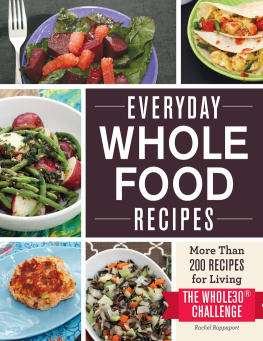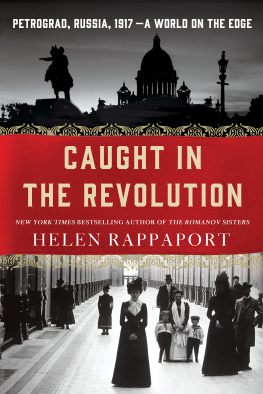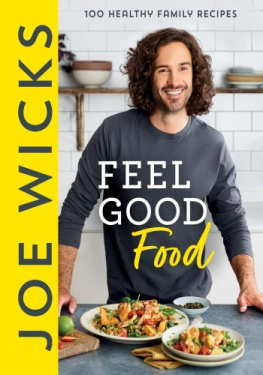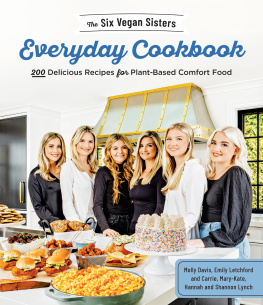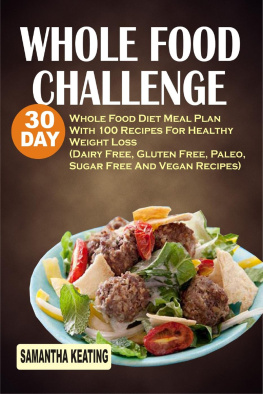Contents
Guide
EVERYDAY
WHOLE
FOOD
RECIPES
More Than 200 RECIPES for Living
THE WHOLE 30 CHALLENGE
Rachel Rappaport

Avon, Massachusetts
Contents
WELCOME!
Youve probably heard your coworkers, Facebook friends, or people at the gym talking about doing a Whole30 Challenge. What is it? Its a plan designed to wean you off eating processed foods and to introduce new, healthful foods into your diet in 30 days. Maybe you want to try the Whole30 Challenge in order to eat more vegetables, maintain a healthier lifestyle, or ease ongoing digestive problems. No matter what reason you have, the recipes in this book will make the process delicious and painless!
What Can I Eat?
The Whole30 Challenge allows you to eat a very wide range of foods:
- All vegetables (including potatoes, both white and sweet!)
- All fruits
- Pickled foods like capers, pickles, relish, and olives
- Eggs
- Nuts and nut butters
- Spices, including fresh or dried herbs
- Fish
- Meat
- Condiments like mustard, mayonnaise, fish sauce, hot sauce, and vinegars
When buying canned or bottled ingredients or foods, check the labels to make sure they do not include restricted ingredients like sugar and soy. Supermarkets with healthy living sections and grocery stores focused on healthy or organic living are great sources for Whole30-compliant ingredients.
On the small no list are these ingredients:
- Grains such as wheat or rye
- Pseudo-grains such as wild rice or quinoa
- Dairy except for ghee (clarified butter)
- Soy
- Sugar
- Legumes such as peanuts or beans
How Much Can I Eat?
Dont worry, youll still be able to eat three meals a day. Each meal should be composed of:
- 36 ounces of easily digestible protein (such as eggs)
- 12 tablespoons of cooking fats like olive oil, animal fat, ghee, or coconut oil, or other Whole30-approved fats such as nuts, seeds, olive oil, nut butter, coconut milk, shredded coconut, or coconut milk
- Vegetables that are higher in carbohydrates such as sweet potatoes, winter squash, and beets
Meals should contain enough food to eliminate the need for snacking throughout the day. The exception is post-workout meals, which serve to replenish the body after a strenuous exercise session.
The first half of this book will provide you with varied Whole30 Challengecompliant full meals, appetizers, sauces, and side dishes to help you on your 30-day journey. Youll find 100 recipes from many different cuisines and regions that will make you forget youre even missing any ingredients!
Life after Whole30
You might feel so healthy, energetic, and strong that you want to continue the Whole30 Challenge after the 30 days are up. But some people miss their favorite foods, are looking for more ease in dining out, or just want to enjoy a slice of cake on their birthday.
The second half of the book is for your life after the Challenge if you want to ease in a few more ingredients that are still unprocessed and healthy but technically fall outside the Whole30 Challenge. To avoid potential gastric distress, its important to introduce new foods slowly and pay attention to how they make you feel. Dont suddenly binge on all the foods you were missing; going from no grains or legumes to a day full of beans, whole-wheat bread, and cake would make anyone feel a little off. Try introducing a small amount of one or two non-Whole30-compliant foods each day.
The recipes in the second section are designed to help you do that by adding anywhere from one to a handful of new ingredients back into your diet. All of the recipes in this section:
- Stick to the whole foods ethos of the Whole30 Challenge
- Contain primarily Whole30-compliant condiments and whole foods like vegetables, fruits, meats, and fish
- Introduce fiber-rich foods like whole grains and legumes back into your diet
Pick and choose which recipes are best for you and feel free to customize them to suit your taste and digestive preferences. For example, if you felt much better restricting sugar and had a bad reaction to re-introducing it, it is probably best to leave it out of your daily meals. If a recipe calls for butter and you are more comfortable sticking with ghee, use ghee instead.
Now, lets start changing how you think about foodone mouthwatering recipe at a time.
PART 1
WHOLE30 CHALLENGE RECIPES
Are you ready to begin the Whole30 Challenge? In this section, you will find a variety of Whole30-compliant recipes that are so delicious you wont feel like you are missing out on anything. Remember, the Whole30 Challenge is designed not only to wean you off eating processed foods but also to introduce new, healthful foods to your diet. These recipes re-imagine old favorites, represent cuisines from around the globe, and perhaps will even introduce you to a new ingredient or two. Enjoy!
CHAPTER 1
Breakfast and Brunch
Crab Scramble
You might not think of seafood as a breakfast food, but its a great way to boost your daily protein intake, especially when combined with eggs. This recipe is a tasty way to use up leftover crab.
SERVES 2
4 eggs, beaten
12 cup blue crab meat
14 teaspoon sea salt
14 teaspoon white pepper
1 tablespoon ghee
- Whisk together the eggs, crab, salt, and pepper until fluffy.
- Meanwhile, heat the ghee in a large skillet over medium heat. Pour in the egg mixture and use a spatula to move it around the skillet, forming curds. Continue to cook, stirring frequently, until the egg is fully cooked, approximately 35 minutes.
- Divide into 2 portions and serve immediately.
THE NOBLE BLUE CRAB
Native to the Atlantic Ocean, the noble blue crab is the Maryland state crustacean. Blue crabs have blue legs and claws when alive but turn bright red when cooked. Blue crab is a relatively low-calorie food; one large crab is only 87 calories yet provides 34 percent of the RDA of protein.
Summer Vegetable Strata
Most stratas use bread and need to be refrigerated hours before making. But this Whole30-compliant non-bread version is ready to bake in less than 15 minutes and is a great way to really pack some veggies into your breakfast.
SERVES 8
8 eggs, beaten
12 cup coarsely chopped snow peas
12 cup halved cherry tomatoes
14 cup minced basil
1 tablespoon minced parsley
12 teaspoon sea salt
12 teaspoon freshly ground black pepper
312 cups loosely packed raw zucchini noodles (zoodles)
- Preheat oven to 425F. Grease an 8" 8" baking dish.
- In a medium bowl, stir together the eggs, snow peas, tomatoes, basil, parsley, salt, and pepper.
- Arrange the zucchini noodles to cover the bottom of the baking dish. Pour the egg mixture over the zucchini noodles.
- Bake for 30 minutes. Cut into squares and serve immediately.
ZOODLING AROUND
Zucchini noodles, also known as zoodles, are all-vegetable noodles. Theyre made by slicing zucchini into thin, noodle-like strips using a specialized manual or battery-powered vegetable spiralizer tool, a serrated vegetable peeler, or the matchstick side of a mandolin.

